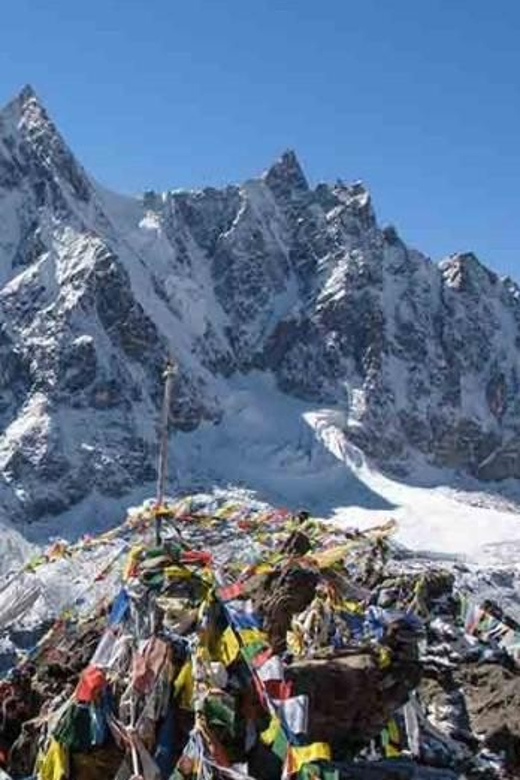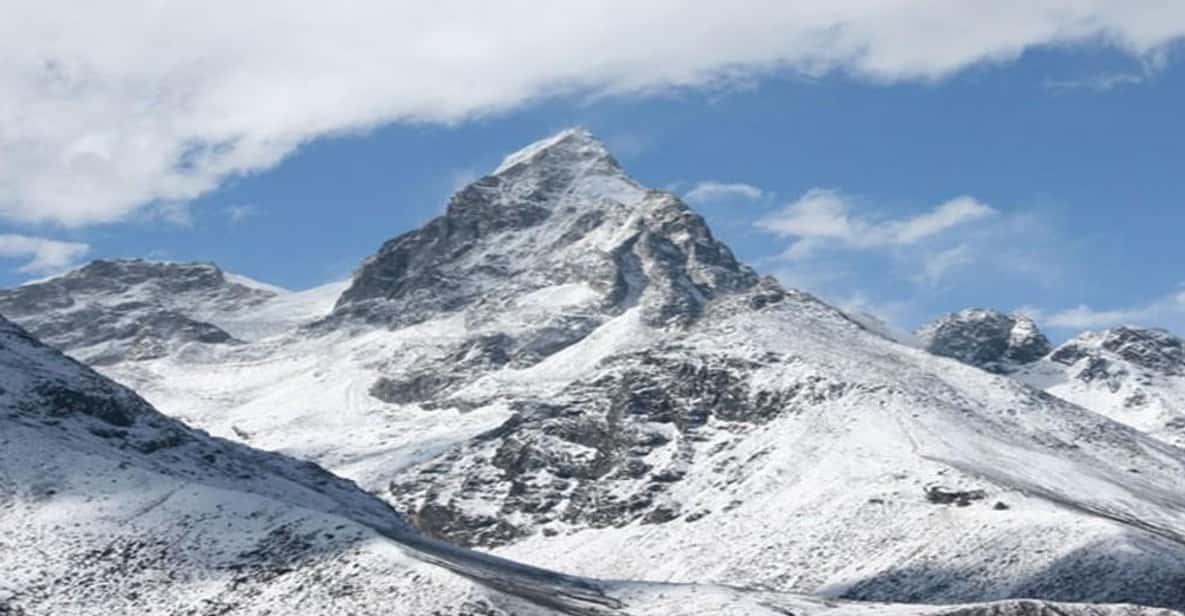Climbing Mt. Phari Lapcha Peak presents an intriguing blend of technical skill and natural wonder, captivating adventurers with its towering height of 6,017 meters. As climbers make their way through the vibrant landscapes of the Nepalese Himalayas, they not only face physical challenges but also enjoy the rich Sherpa culture. The journey typically begins in Kathmandu, leading to acclimatization in Namche Bazaar before the summit attempt. But what really sets this climb apart are the hidden gems along the route that promise to surprise even the most seasoned trekkers. What might those be?
Key Points

- Phari Lapcha Peak stands at 6,017 meters and is located between Gokyo Valley and Everest Base Camp trekking routes.
- Climbing requires technical skills and physical endurance, with optimal conditions in April and May.
- The trek includes a rich cultural experience through traditional Sherpa villages and stunning landscapes.
- A professional support team of guides and porters is included, along with quality camping gear and meals.
- Budget for personal expenses and equipment rentals, and ensure you have travel insurance for safety.
Overview of Phari Lapcha Peak
Phari Lapcha Peak, soaring at an impressive 6,017 meters (19,741 feet) in the heart of the Nepalese Himalayas, presents a thrilling challenge for adventurous mountaineers eager to conquer its heights.
Nestled between the popular trekking routes to Gokyo Valley and Everest Base Camp, it offers stunning panoramic views of towering peaks and pristine glacial lakes.
While the ascent demands solid technical skills and physical endurance, climbers are rewarded with breathtaking landscapes and a sense of accomplishment.
The region’s rich culture, adorned with traditional Sherpa villages, adds to the experience, making the journey not just about the summit but also about connecting with nature and local heritage.
Phari Lapcha Peak truly embodies the spirit of Himalayan adventure.
You can also read our reviews of more tours and experiences in Namche Bazar.
Detailed Climbing Itinerary

The detailed climbing itinerary for Phari Lapcha Peak offers a well-structured plan that guides adventurers through each stage of their exhilarating journey in the Himalayas. Each day is designed to build endurance and allow for acclimatization, ensuring a successful summit.
| Day | Activity | Location |
|---|---|---|
| 1 | Arrival at Kathmandu | Kathmandu |
| 2 | Fly to Lukla, trek to Phakding | Phakding |
| 3 | Trek from Phakding to Namche Bazaar | Namche Bazaar |
| 4 | Acclimatization day | Namche Bazaar |
| 5 | Trek from Namche to Dole | Dole |
| 6 | Dole to Machhermo | Machhermo |
| 7 | Trek to Gokyo Lake | Gokyo Lake |
| 8 | Ascent of Gokyo Ri | Gokyo Lake |
| 9 | Gokyo Lake to Base Camp | Phari Lapcha Base Camp |
| 10 | Set up High Camp | High Camp |
| 11 | Summit Phari Lapcha, descend to Gokyo | Gokyo |
| 12 | Gokyo Lake to Dole | Dole |
| 13 | Dole to Namche Bazaar | Namche Bazaar |
| 14 | Namche to Lukla | Lukla |
| 15 | Fly to Kathmandu | Kathmandu |
| 16 | Free day in Kathmandu | Kathmandu |
| 17 | Final Departure | Kathmandu |
Inclusions and Services
Adventurers can expect a comprehensive range of inclusions and services designed to enhance their climbing experience and ensure a smooth journey to Phari Lapcha Peak. These offerings cater to the needs of climbers from the moment they arrive in Nepal until they reach their final destination.
-
Private airport pick-up and drop-off for convenience.
-
Comfortable hotel accommodation in Kathmandu with breakfast.
-
Daily meals crafted by an experienced cook for nutrition.
-
Quality camping gear, including tents and kitchen facilities.
-
Professional support team, including guides and porters, to facilitate the trek.
With these inclusions, climbers can focus on the adventure ahead, confident that their basic needs are well taken care of throughout the expedition.
Additional Costs
Climbers should budget for additional costs that may arise during their expedition, ensuring they’re fully prepared for any unexpected expenses.
Personal equipment rentals in Kathmandu typically cost around US$1 per item per day, which can add up. Participants should also consider an equipment allowance for Sherpa guides and porters, averaging approximately US$170 each.
Travel and medical insurance, along with potential emergency evacuation costs, are essential to factor in for safety.
Plus, personal expenses such as laundry, phone calls, alcoholic beverages, and tips can accumulate throughout the journey.
More Great Tours NearbyBooking Information
Booking a spot for the Phari Lapcha Peak climbing expedition is straightforward and offers flexible options to suit various preferences. The process is designed to be user-friendly, ensuring adventurers can secure their place with ease.
Prices start at Kč68,847 per person.
Free cancellation is available up to 24 hours before departure.
Reserve now & pay later allows for booking without upfront payment.
The expedition is valid for 17 days from the first activation.
Multiple language options are available for live tour guides, including English, Japanese, Hindi, Nepali, and French.
This booking structure not only accommodates different needs but also enhances the overall climbing experience, making it accessible for everyone eager to conquer the peak.
Best Time to Climb
The best time to climb Phari Lapcha Peak is during the spring months of April and May, when the weather is generally stable and the views are breathtaking.
During this period, climbers can expect clear skies and milder temperatures, making it ideal for both novice and experienced mountaineers. The snow conditions are also favorable, providing a solid and reliable surface for ascent.
Plus, the vibrant flora in the region comes alive, enhancing the trekking experience.
While autumn months, particularly late September to October, also offer good conditions, spring remains the preferred choice for many.
Planning a trip during these months maximizes the chances of a successful and enjoyable climb to this stunning Himalayan peak.
Safety and Preparation
Preparing for a climb of Phari Lapcha Peak requires careful attention to safety protocols and adequate acclimatization to the high-altitude environment. Climbers should prioritize their well-being by adhering to essential guidelines and preparing thoroughly for the expedition.
-
Carry a comprehensive first-aid kit.
-
Stay hydrated to combat altitude sickness.
-
Practice using climbing gear before the ascent.
-
Consult with a medical professional for fitness evaluation.
-
Familiarize with emergency evacuation procedures.
Local Culture and Environment
Local communities surrounding Phari Lapcha Peak are rich in culture, showcasing unique traditions and lifestyles deeply intertwined with the breathtaking Himalayan environment.
The Sherpa people, known for their exceptional mountaineering skills, play a vital role in the region’s culture. Their hospitality is legendary; trekkers often experience warm welcomes and delicious local cuisine.
Festivals like Losar, the Tibetan New Year, bring vibrant celebrations filled with music, dance, and traditional rituals.
The pristine environment also holds spiritual significance, with many locals believing that the mountains are sacred.
Conservation efforts by these communities help preserve the stunning landscapes and biodiversity, ensuring future generations can enjoy the natural beauty of the Himalayas while maintaining their cultural heritage.
Frequently Asked Questions
What Is the Physical Fitness Requirement for Climbing Phari Lapcha Peak?
For high-altitude climbing, individuals need good physical fitness. They should build endurance, strength, and cardiovascular health through regular training, as it enhances their ability to tackle challenging terrains and cope with altitude-related difficulties.
Are There Age Restrictions for Participants in the Climbing Expedition?
The expedition doesn’t impose strict age restrictions, but participants should be physically fit and mentally prepared. Generally, climbers aged 18 to 60 find success, while older adventurers may join with proper fitness and experience.
What Type of Food Is Served During the Trek?
During the trek, participants enjoy daily meals prepared by an experienced cook. The menu typically includes local dishes, fresh vegetables, and hearty staples, ensuring everyone stays energized and satisfied throughout their adventurous journey.
Can I Bring My Own Climbing Gear?
Yes, participants can bring their own climbing gear. It’s encouraged to ensure comfort and familiarity with equipment. However, renting gear in Kathmandu is also available for those who prefer not to carry everything.
How Do I Prepare for High-Altitude Sickness?
To prepare for high-altitude sickness, he should acclimatize gradually, stay hydrated, avoid alcohol, and recognize symptoms early. Consulting a doctor about preventive medication can also be helpful for a safer climbing experience.
Recap
Climbing Mt. Phari Lapcha Peak is an unforgettable journey that blends adventure with the stunning beauty of the Himalayas.
With proper preparation, climbers can tackle its challenges and enjoy the rich Sherpa culture.
Whether you’re gazing at panoramic views or navigating technical terrains, the experience is sure to leave a lasting impression.
So, if you’re seeking an exhilarating adventure, Phari Lapcha Peak awaits, ready to reward you with memories that will last a lifetime.
You can check availability for your dates here:More Tour Reviews in Namche Bazar
Not for you? Here's more nearby things to do in Namche Bazar we have reviewed
- Everest Base Camp Trek – 12 Days Guided Trek
- Lobuche Peak Climbing 2025/2026
- Everest Panorama Trek-10 Days
- Lobuche Peak Climbing with EBC TREK-18 Days
- Everest Base Camp, Cho-La Pass, and Gokyo Trek
- Guided: Everest Base Camp Trek
- Pokhara: 11-Day Everest Base Camp Trek
- Everest Base Camp Trek
- Everest: 6-Day Panorama Trek
- 12 days Everest Base Camp Trek
- 5-Day Everest Tour with Breakfast at Everest View Hotel
- 8 DAYS EVEREST PANORAMA VIEW TREK FROM KATHMANDU
